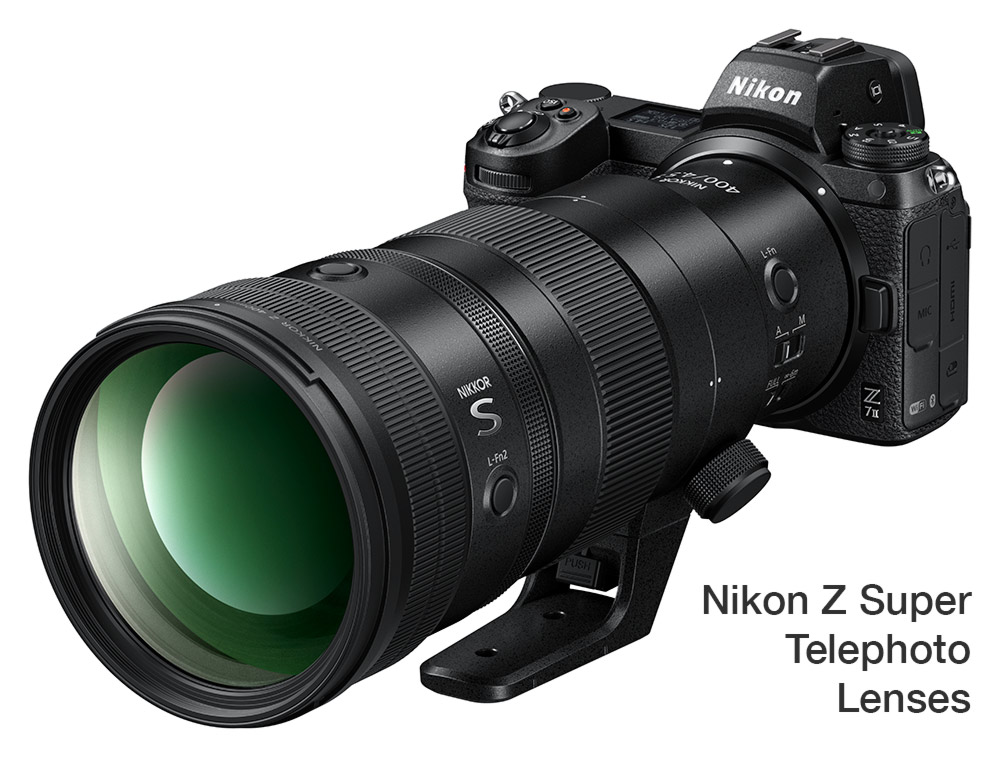- Call us: 01444 237070
- Contact Us
- Stores
- Sign In / Register
-
- Back
- Used Cameras
- Used Accessories
- Used Lenses
- Used Video
- Used Film Equipment
- Used Stock Alert
- Used Blank Test
- Sell or Part Exchange
- Used Clearance
- Recently Added Used Equipment
- Park Picks
- All Used Black Friday Deals
- Faulty
- Trade-In
- Blog
- New in
- Call us
- Contact us
- Stores
- Sign in
- Categories
- Tips & Inspiration
- Reviews
- News
- Events
- Features
- Buying Guides
- Competitions
Nikon Z Super Telephoto Lens Comparison
With the release of the Nikon Z 400mm f/4.5 VR S we decided a Nikon Z super telephoto lens comparison was in order. For this we’ve gathered specifications for the Z 800mm F/6.3 VR S Lens and Z 100-400mm f/4.5-5.6 VR S Lens to find out which offers the best bang for your buck.

What are Nikons super telephoto mirrorless lenses for?
Professional sports, action and wildlife photographers expect a selection of super telephoto lenses to choose from, with any camera system they’re invested into. Nikon is working hard on providing their these long-lens shooters with a range of options, with the Z 400mm f/4.5 VR S arriving in June 2022, hot on the heels of the April 2022 release of the Z 800mm F/6.3 VR S.
It’s no coincidence that the flagship Z9 sports and wildlife camera has been a huge success and is destined to be the preferred Nikon mirrorless camera body for many users of these super telephoto lenses. That’s not to say enthusiasts who shoot similar subjects with a Z6 or Z7 (mark I or II), or even crop sensor cameras like a Z5, won’t be more than a little interested. One of the benefits of APS-C format is that you can mount any Nikon mirrorless lens onto an APS-C (DX) camera and you’ll get 1.5x greater reach, which is very nice for these kinds of subjects.
Speaking of subjects at least two of these lenses are also used for portraits where 400mm delivers fabulous compression, as well as landscapes to capture vignettes and even fashion, aviation and any subject where a long reach is beneficial.

Mirrorless Z teleconverter compatibility
It is great news that three lenses are compatible with Nikon’s mirrorless teleconverters, which are the Z 1.4x Teleconverter and Z 2.0x Teleconverter. We thought it would be useful to add some information about these in order for you to gain a better understanding of how using them will impact each lens.
|
|
||
|
Light loss |
One stop |
Two stops |
|
Lens construction |
6 elements / 4 groups (including 1 aspherical element) |
8 elements / 5 groups (including 1 aspherical element) |
|
Fluorine coat |
Front and rear elements |
Front and rear elements |
|
Minimum focus distance |
Same as the Telephoto lens |
Same as the Telephoto lens |
|
Weather sealed |
YES |
YES |
|
Length |
18.5mm |
32.5 mm |
|
Weight |
Approx. 220g |
Approx. 270g |
Both of the teleconverters are superbly engineered with plenty of optics to deliver the best performance possible, all with only one or two stops of light reduction. Minimum focus distance remains unchanged and they are also both extremely lightweight for the magnification they offer (40% more or 100% more), which means you’ll be able to get significantly greater reach with any of the super telephoto lenses without much weight penalty.
S-Line lens optics
The three Nikon Z super telephoto lenses which we are comparing are all S-Line models. S-Line is essentially the premium range of Nikon mirrorless lenses, which are designed to deliver professional performance with improved bokeh. Primary benefits which S-Line offers include:
- High resolving power with excellent sharpness
- Minimal colour fringing and image artefacts
- Improved bokeh characteristics with rounded shapes
- Minimal focus breathing for videography
- Weather sealing
Nikon Z mirrorless super telephoto lens comparison
The table below shows essential specifications for each of these three lenses, which all compare extremely favourably. What this means for Nikon photographers is that they now have a selection of long lenses to choose from for their fast-paced and distant subject photography.
|
|
|||
|
S-Line |
YES |
YES |
YES |
|
AF motor |
STM (stepping motor) |
STM (stepping motor) |
x2 STM (stepping motor) |
|
Vibration reduction |
YES |
YES |
YES |
|
Focusing system |
Internal |
Internal |
Internal |
|
Minimum focus distance |
2.5m |
5m |
wide 0.75m - tele 0.98m |
|
Maximum magnification ratio |
0.16x |
0.16x |
0.38x |
|
Teleconverter compatible |
YES |
YES |
YES |
|
Programmable buttons |
YES |
YES |
YES |
|
Aperture range |
f/4.5 - f/32 |
f/6.3 - f/32 |
Variable f/4.5 - f/5.6 to f/32 - f40 |
|
Aperture blades |
9 |
9 |
9 |
|
Lens configuration |
19 elements / 13 groups |
22 elements / 14 groups |
25 elements / 20 groups |
|
Special lenses |
1 ED, 2 Super ED and 1 SR |
3 ED, 1 SR and 1 PF |
6 ED, 2 super-ED |
|
Fluorine coat |
YES |
YES |
YES |
|
Nano Crystal coat |
YES |
YES |
YES |
|
Filter size |
95mm |
46mm (slip-in) |
77mm |
|
Length |
234.5mm |
385mm |
222mm |
|
Weight |
1,245g |
2,385g |
1,435g |
|
Price June 2022 |
£3,299.00 |
£6,299.00 |
£2,699.00 |
What about the Nikon Z 400mm F/2.8 TC VR S?
We decided to leave out the Nikon Z 400mm F/2.8 TC VR S lens due to its £13,5k price tag. Whilst it is the fastest lens, it is also costs more than four times the price of the new 400mm, which places it into a whole different category from these three models.
Summary
The arrival of the Z9 was a breakthrough moment for Nikon’s mirrorless platform and the addition of the Nikon Nikkor Z 400mm f/4.5 VR S lens will no doubt tempt some more DSLR shooters across to the system. It is incredibly compact, fast and includes all of the ingredients to satisfy enthusiast and professional users. In fact all three of these lenses offer a great deal for Nikon mirrorless users to be happy about and reassure themselves they are invested in one of the world’s leading mirrorless camera systems.
Explore the Nikon Z 400mm f/4.5 VR S product here for your telephoto subjects.

New Nikon vlogging camera
We would be bereft if we didn’t mention the Nikon Z30 which joined the Z 400mm f/4.5 VR S release. The latest mirrorless camera is small, capable and made to be as simple to use as possible for anyone who wants to move beyond a smartphone with better-looking, better-sounding vlogs.
It combines everything you need for content creation with features which we love about Nikon cameras, such as a vari-angle touchscreen monitor, rep grip and beautiful 4K UHD movies.
Share this post:
By Nick Dautlich on 29/06/2022
Nick Dautlich
Senior Content Writer and Product Reviewer
Nick Dautlich is the Senior Content Writer and Product Reviewer at Park Cameras, with over 15 years of photography experience. A Sony Imaging Professional and expert reviewer, Nick has worked with major brands such as Canon, Sony and Nikon. His work is also featured on Vanguard World UK’s website, Capture Landscapes, and Shutter Evolve. Nick’s photography includes National Trust projects and magazine covers and he is passionate about landscapes and storytelling. Nick also enjoys hiking and teaching his children about nature. Learn more on his profile page.

Trade in your old equipment
Fast and easy trade in service ensures your old gear is collected efficiently and you are paid quickly! It's very simple to trade in your unwanted photography gear. Just head over to our dedicated Sell or Part Exchange page, fill out the details, and we'll get back to you with an offer for your old gear. Take the cash, or put it towards the cost of your new gear. It's up to you! Find out more
sign up to the newsletter
Keep up to date on the latest photography news, events and offers. Sign up now
